Thelonious Monk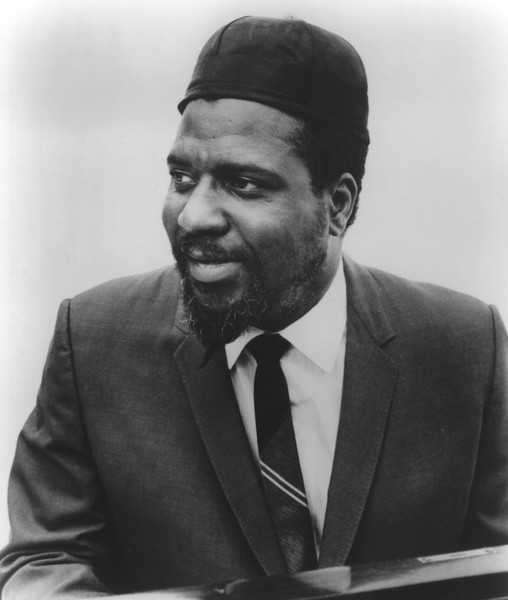 | ||
| Allmusic Biography : The most important jazz musicians are the ones who are successful in creating their own original world of music with its own rules, logic, and surprises. Thelonious Monk, who was criticized by observers who failed to listen to his music on its own terms, suffered through a decade of neglect before he was suddenly acclaimed as a genius; his music had not changed one bit in the interim. In fact, one of the more remarkable aspects of Monks music was that it was fully formed by 1947 and he saw no need to alter his playing or compositional style in the slightest during the next 25 years. Thelonious Monk grew up in New York, started playing piano when he was around five, and had his first job touring as an accompanist to an evangelist. He was inspired by the Harlem stride pianists (James P. Johnson was a neighbor) and vestiges of that idiom can be heard in his later unaccompanied solos. However, when he was playing in the house band of Mintons Playhouse during 1940-1943, Monk was searching for his own individual style. Private recordings from the period find him sometimes resembling Teddy Wilson but starting to use more advanced rhythms and harmonies. He worked with Lucky Millinder a bit in 1942 and was with the Cootie Williams Orchestra briefly in 1944 (Williams recorded Monks "Epistrophy" in 1942 and in 1944 was the first to record "Round Midnight"), but it was when he became Coleman Hawkins regular pianist that Monk was initially noticed. He cut a few titles with Hawkins (his recording debut) and, although some of Hawkins fans complained about the eccentric pianist, the veteran tenor could sense the pianists greatness. The 1945-1954 period was very difficult for Thelonious Monk. Because he left a lot of space in his rhythmic solos and had an unusual technique, many people thought that he was an inferior pianist. His compositions were so advanced that the lazier bebop players (although not Dizzy Gillespie and Charlie Parker) assumed that he was crazy. And Thelonious Monks name, appearance (he liked funny hats), and personality (an occasionally uncommunicative introvert) helped to brand him as some kind of nut. Fortunately, Alfred Lion of Blue Note believed in him and recorded Monk extensively during 1947-1948 and 1951-1952. He also recorded for Prestige during 1952-1954, had a solo set for Vogue in 1954 during a visit to Paris, and appeared on a Verve date with Bird and Diz. But work was very sporadic during this era and Monk had to struggle to make ends meet. His fortunes slowly began to improve. In 1955, he signed with Riverside and producer Orrin Keepnews persuaded him to record an album of Duke Ellington tunes and one of standards so his music would appear to be more accessible to the average jazz fan. In 1956 came the classic Brilliant Corners album, but it was the following year when the situation permanently changed. Monk was booked into the Five Spot for a long engagement and he used a quartet that featured tenor saxophonist John Coltrane. Finally, the critics and then the jazz public recognized Thelonious Monks greatness during this important gig. The fact that he was unique was a disadvantage a few years earlier when all modern jazz pianists were expected to sound like Bud Powell (who was ironically a close friend), but by 1957 the jazz public was looking for a new approach. Suddenly, Monk was a celebrity and his status would not change for the remainder of his career. In 1958, his quartet featured the tenor of Johnny Griffin (who was even more compatible than Coltrane), in 1959 he appeared with an orchestra at Town Hall (with arrangements by Hall Overton), in 1962 he signed with Columbia and two years later was on the cover of Time. A second orchestra concert in 1963 was even better than the first and Monk toured constantly throughout the 1960s with his quartet which featured the reliable tenor of Charlie Rouse. He played with the Giants of Jazz during 1971-1972, but then in 1973 suddenly retired. Monk was suffering from mental illness and, other than a few special appearances during the mid-70s, he lived the rest of his life in seclusion. After his death it seemed as if everyone was doing Thelonious Monk tributes. There were so many versions of "Round Midnight" that it was practically a pop hit! But despite the posthumous acclaim and attempts by pianists ranging from Marcus Roberts to Tommy Flanagan to recreate his style, there was no replacement for the original. Some of Thelonious Monks songs became standards early on, most notably "Round Midnight," "Straight No Chaser," "52nd Street Theme," and "Blue Monk." Many of his other compositions have by now been figured out by other jazz musicians and are occasionally performed including "Ruby My Dear," "Well You Neednt," "Off Minor," "In Walked Bud," "Misterioso," "Epistrophy," "I Mean You," "Four in One," "Criss Cross," "Ask Me Now," "Little Rootie Tootie," "Monks Dream," "Bemsha Swing," "Think of One," "Friday the 13th," "Hackensack," "Nutty," "Brilliant Corners," "Crepuscule With Nellie" (written for his strong and supportive wife), "Evidence," and "Rhythm-a-Ning," Virtually all of Monks recordings (for Blue Note, Prestige, Vogue, Riverside, Columbia, and Black Lion) have been reissued and among his sidemen through the years were Idrees Sulieman, Art Blakey, Milt Jackson, Lou Donaldson, Lucky Thompson, Max Roach, Julius Watkins, Sonny Rollins, Clark Terry, Gerry Mulligan, John Coltrane, Wilbur Ware, Shadow Wilson, Johnny Griffin, Donald Byrd, Phil Woods, Thad Jones, and Charlie Rouse. His son Thelonious Monk, Jr. (T.S. Monk) has helped keep the hard bop tradition alive with his quintet and has headed the Thelonious Monk Institute, whose yearly competitions succeed in publicizing talented young players. | ||
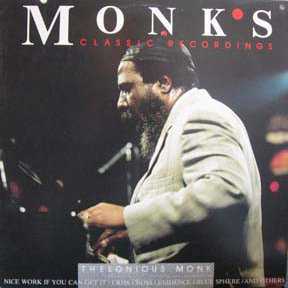 | Album: 1 of 39 Title: Monks Classic Recordings Released: Tracks: 12 Duration: 54:51 Scroll: Up Down Top Bottom 25% 50% 75% AlbumCover | 1 Blue Sphere (02:23) 2 Evidence (05:22) 3 Criss Cross (03:41) 4 Nice Work If You Can Get It (05:10) 5 Jackie-Ing (03:27) 6 The Man I Love (05:11) 7 Crepescule With Nellie (02:21) 8 Little Rootie Tootie (04:04) 9 Trinkle Tinkle (05:53) 10 Ruby My Dear (06:02) 11 Nutty (04:42) 12 Something in Blue (06:30) |
 | Album: 2 of 39 Title: Genius of Modern Music Released: 1951 Tracks: 12 Duration: 37:00 Scroll: Up Down Top Bottom 25% 50% 75% Spotify Allmusic Wikipedia AlbumCover | 1 Round Midnight (03:12) 2 Off Minor (03:01) 3 Ruby My Dear (03:09) 4 I Mean You (02:45) 5 April in Paris (03:21) 6 In Walked Bud (02:56) 7 Thelonious (03:01) 8 Epistrophy (03:08) 9 Misterioso (03:21) 10 Well, You Needn’t (02:59) 11 Introspection (03:12) 12 Humph (02:53) |
 | Album: 3 of 39 Title: Genius of Modern Music, Volume 2 Released: 1952 Tracks: 18 Duration: 1:00:44 Scroll: Up Down Top Bottom 25% 50% 75% AlbumCover | 1 Four in One (03:32) 2 Criss Cross (02:57) 3 Eronel (03:06) 4 Straight No Chaser (02:59) 5 Ask Me Now (03:17) 6 Willow Weep for Me (03:02) 7 Nice Work If You Can Get It (03:30) 8 Criss Cross (alternate take) (02:52) 9 Ask Me Now (alternate take) (04:31) 10 Skippy (03:02) 11 Hornin’ In (03:15) 12 Sixteen (second take) (03:43) 13 Carolina Moon (03:29) 14 Let’s Cool One (03:50) 15 I’ll Follow You (03:49) 16 Skippy (alternate take) (03:11) 17 Hornin’ In (alternate take) (03:10) 18 Sixteen (first take) (03:29) |
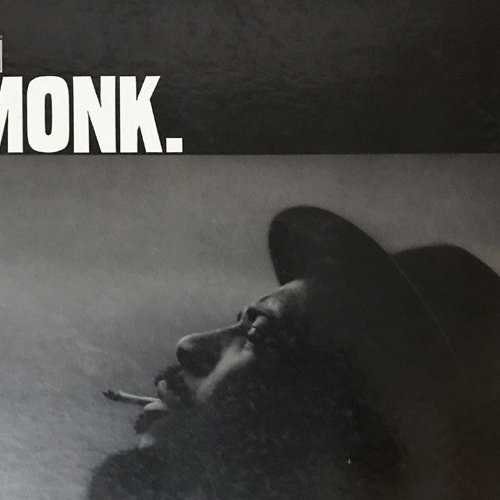 | Album: 4 of 39 Title: Monk Released: 1954 Tracks: 7 Duration: 38:01 Scroll: Up Down Top Bottom 25% 50% 75% Spotify Allmusic Wikipedia AlbumCover | 1 We See (05:16) 2 Smoke Gets in Your Eyes (04:34) 3 Locomotive (06:23) 4 Hackensack (05:13) 5 Let’s Call This (05:08) 6 Think of One (take 2) (05:47) 7 Think of One (take 1) (05:37) |
| Monk : Allmusic album Review : Thelonious Monks Prestige recordings (reissued on three LP-length CDs) have been somewhat neglected through the years but, with the exception of a date for Vogue, they are the only documentation that exists of the unique pianist-composers work as a leader during the latter half of 1952 through 1954. This set has four numbers (including Monks originals "Wee See," "Locomotive" and the catchy "Hackensack") featuring Monk with trumpeter Ray Copeland (an underrated player), tenor saxophonist Frank Foster, bassist Curly Russell and drummer Art Blakey. However it is "Lets Call This" and the two versions of "Think of One" that are best-known, for Monk teams up with the French horn wizard Julius Watkins, bassist Percy Heath, drummer Willie Jones and the great tenor Sonny Rollins. Every Thelonious Monk recording is well worth getting although this one is not quite essential. | ||
 | Album: 5 of 39 Title: Piano Solo Released: 1954 Tracks: 9 Duration: 31:01 Scroll: Up Down Top Bottom 25% 50% 75% Spotify Allmusic AlbumCover | 1 Round About Midnight (05:16) 2 Evidence (03:06) 3 Smoke Gets in Your Eyes (03:25) 4 Well You Neednt (03:26) 5 Reflections (05:01) 6 We See (02:37) 7 Eronel (02:34) 8 Off Minor (02:32) 9 Hackensack (03:01) |
| Piano Solo : Allmusic album Review : This reissue of the Everest LP Piano Solos by Thelonious Monk showcases the great composer and innovator on eight tunes, recorded in 1954. While "Round Midnight," is here, so is "Off Minor," "Well You Neednt," and his gorgeous reading of "Smoke Gets in Your Eyes." If you own any of the Riverside or Columbia sides of Monk playing alone, you still need this, because these readings are very different. Collectables gets kudos for re-releasing this one, even if it came from a pristine vinyl copy. | ||
 | Album: 6 of 39 Title: Thelonious Monk Plays Duke Ellington Released: 1955 Tracks: 8 Duration: 37:16 Scroll: Up Down Top Bottom 25% 50% 75% Spotify AlbumCover | 1 It Don’t Mean a Thing (If It Ain’t Got That Swing) (04:41) 2 Sophisticated Lady (04:31) 3 I Got It Bad (and That Ain’t Good) (05:56) 4 Black and Tan Fantasy (03:26) 5 Mood Indigo (03:16) 6 I Let a Song Go Out of My Heart (05:43) 7 Solitude (03:45) 8 Caravan (05:55) |
 | Album: 7 of 39 Title: The Unique Thelonious Monk Released: 1956 Tracks: 7 Duration: 38:24 Scroll: Up Down Top Bottom 25% 50% 75% Spotify TrackSamples Wikipedia Allmusic AlbumCover | 1 Liza (All the Cloudsll Roll Away) (03:13) 2 Memories of You (04:17) 3 Honeysuckle Rose (05:34) 4 Darn That Dream (06:30) 5 Tea for Two (05:55) 6 You Are Too Beautiful (04:56) 7 Just You, Just Me (07:57) |
| The Unique Thelonious Monk : Allmusic album Review : The seven-song Unique Thelonious Monk (1956) platter was the pianists second during his remarkable five-year tenure on Riverside. His debut for the label was the aptly titled Plays Duke Ellington (1955) and once again, on this disc, Monks song selection did not feature any original compositions. Rather, the well-chosen standards included exemplify and help further establish the pianist and bandleader within the context of familiar melodies at the head of a trio -- consisting of Oscar Pettiford (bass) and Art Blakey (drums). Regarding the personnel, while Pettiford had also accompanied Monk on the Ellington sides, Blakey replaces Kenny Clarke. The pairing of Monk and Blakey cannot be overstated. Immediately, evidence of their uncanny instrumental interaction is the rhythmic focal point of "Liza, All the Cloudsll Roll Away" as the two play musical cat-and-mouse. They cajole and wheedle atop Pettifords undulating undercurrent as it sonically corals their skilled syncopation and otherwise inspired mile-a-minute interjections. This is starkly contrast to the haunting, lyrical piano solo on "Memories of You." Monk infuses the piece with such profound ingenuity and integrity that his re-evaluation and innovative arrangement are singularly and undeniably his own. Fats Wallers "Honeysuckle Rose" reels with a frolicking and ever-so-slightly inebriated gate. It is likewise highlighted by Monks dreamlike single-note runs up and down the keyboard and the stride piano-style chord progressions that preserves a fluidity within the tune. The advanced score maintains a guise of almost goofy abandon within Monks highly logical and well-sculpted musical structure. The juxtaposition of "Darn That Dream" is another study in the vacillating moods of The Unique Thelonious Monk. The sophisticated performance is understated, yet remains loose and limber and perfectly in keeping with the albums leitmotif of exploring Monks skills as an arranger and musician. As if he were testing his audience, the manic and atonal opening to "Tea for Two" -- briefly featuring Pettiford on bowed upright bass -- rollicks with a youthful visage, rather than being a simple reworking of this well-established classic. This LP concludes with one of Monks most memorable pieces on the fun and freewheeling "Just You, Just Me." The trio struts and glides as Monks intricate fingering simultaneously displays his physical dexterity as well as his ability to play so deftly in the moment. Both attributes would resurface ten-fold once Monk began to animate his own compositions on the genre-defining Brilliant Corners (1956). | ||
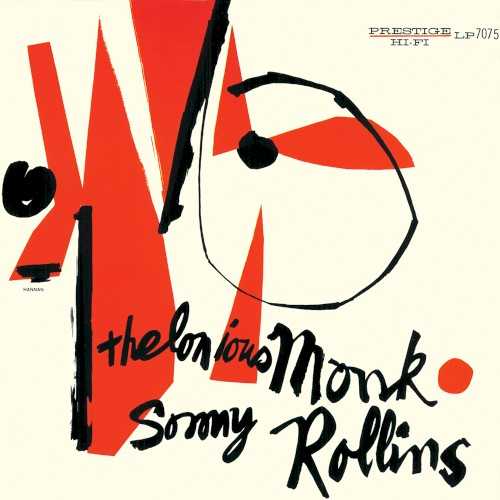 | Album: 8 of 39 Title: Thelonious Monk & Sonny Rollins Released: 1956 Tracks: 5 Duration: 34:16 Scroll: Up Down Top Bottom 25% 50% 75% Spotify Wikipedia Allmusic AlbumCover | 1 The Way You Look Tonight (05:15) 2 I Want to Be Happy (07:46) 3 Work (05:20) 4 Nutty (05:19) 5 Friday the 13th (10:33) |
| Thelonious Monk & Sonny Rollins : Allmusic album Review : This disc contains an all-star cast headed up by Thelonious Monk (piano) and includes some collaborative efforts with Sonny Rollins (tenor sax) that go beyond simply inspired and into a realm of musical telepathy. The five tunes included on Work are derived from three separate sessions held between November of 1953 and September of the following year. As is often the case, this likewise means that there are three distinct groups of musicians featured. Whether by design or happenstance, the tracks compiled for this EP present Monk in the favorable confines and settings of smaller combos, ranging from the intimacy of the Percy Heath (bass) and Art Blakey (drums) trio on "Nutty" as well as the equally grooving title track. Both utilize Monks uncanny and distinct sense of melody and are conspicuous for Blakeys rollicking percussive contributions -- which, at times, become thrust between Monks disjointed chord work. The larger quartet and quintet settings are equally as inventive, retaining the highly inventive atmosphere. However, the undeniable highlight is the interaction between Monk and Rollins. Leading off the disc is a definitive and freewheeling reading of the pop standard "The Way You Look Tonight." Equally as scintillating is "I Want to Be Happy," both of which are also highlighted by Art Taylor (drums) and Tommy Potter (bass). They provide a supple and unencumbered framework for the soloists to weave their inimitable and often contrasting contributions. The final track is the beautifully dissonant and extended "Friday the Thirteenth," which is ironically the first fortuitous collaboration between the two co-leads. Rollins is able to entwine a sinuous lead throughout Monks contrasting chord counterpoint. Enthusiasts seeking additional tracks from these and the remainder of Monks sessions during his brief residency with Prestige should consider the suitably titled four-CD Complete Prestige Recordings compilation. | ||
![Allmusic album Review : Mulligan Meets Monk documents the 1957 meeting of two sharp musical minds. Though the pairing may seem unlikely, baritone saxophonist Gerry Mulligan -- whose cool, West Coast style blends dexterity with laid-back grace -- and Thelonious Monk -- whose radical, angular piano playing and thoroughly modern compositions are blueprints for the possibilities of bop -- sound remarkable together. In fact, it is the contrast between the players styles that lends this set its balance and appeal. The program, which includes four compositions by Monk and one by Mulligan, is unassailable. Mulligan acquits himself admirably on the Monk classics "Round Midnight," "Rhythm-a-ning," and "Straight, No Chaser," unfurling his smooth tone over their zigzagging melodies and ambitious scalar architecture. Mulligans "Decidedly," a bright bop workout, fits easily alongside Monks tunes, especially with the help of Monks off-kilter, accented comping. Bassist Wilbur Ware and drummer Shadow Wilson lend solid support to the spirited playing of the two leaders, making this top-notch session -- with its great tunes, chemistry, and soloing -- a true classic. [Some reissues include a handful of alternate takes.] mulligan_meets_monk](../../images/thelonious_monk-mulligan_meets_monk.jpg) | Album: 9 of 39 Title: Mulligan Meets Monk Released: 1957 Tracks: 9 Duration: 59:29 Scroll: Up Down Top Bottom 25% 50% 75% Spotify Allmusic AlbumCover | 1 Round Midnight (08:28) 2 Rhythm-A-Ning (05:19) 3 Sweet & Lovely (07:17) 4 Decidedly (take 4) (05:52) 5 Decidedly (take 5) (06:37) 6 Straight, No Chaser (take 3) (07:00) 7 Straight, No Chaser (take 1) (05:29) 8 I Mean You (take 4) (06:53) 9 I Mean You (take 2) (06:31) |
| Mulligan Meets Monk : Allmusic album Review : Mulligan Meets Monk documents the 1957 meeting of two sharp musical minds. Though the pairing may seem unlikely, baritone saxophonist Gerry Mulligan -- whose cool, West Coast style blends dexterity with laid-back grace -- and Thelonious Monk -- whose radical, angular piano playing and thoroughly modern compositions are blueprints for the possibilities of bop -- sound remarkable together. In fact, it is the contrast between the players styles that lends this set its balance and appeal. The program, which includes four compositions by Monk and one by Mulligan, is unassailable. Mulligan acquits himself admirably on the Monk classics "Round Midnight," "Rhythm-a-ning," and "Straight, No Chaser," unfurling his smooth tone over their zigzagging melodies and ambitious scalar architecture. Mulligans "Decidedly," a bright bop workout, fits easily alongside Monks tunes, especially with the help of Monks off-kilter, accented comping. Bassist Wilbur Ware and drummer Shadow Wilson lend solid support to the spirited playing of the two leaders, making this top-notch session -- with its great tunes, chemistry, and soloing -- a true classic. [Some reissues include a handful of alternate takes.] | ||
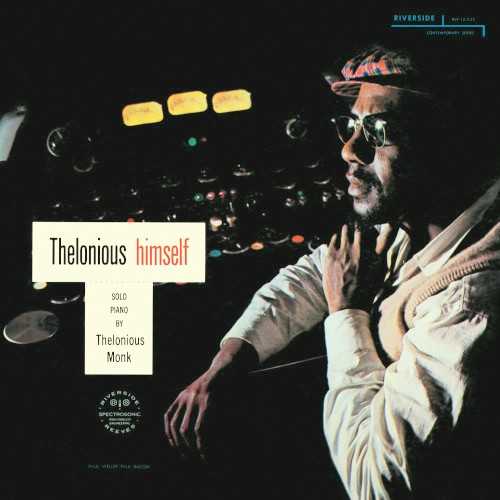 | Album: 10 of 39 Title: Thelonious Himself Released: 1957 Tracks: 13 Duration: 1:06:21 Scroll: Up Down Top Bottom 25% 50% 75% Spotify Allmusic Wikipedia AlbumCover | 1 April In Paris (03:54) 2 (I Dont Stand) A Ghost of a Chance (With You) (take 7) (04:24) 3 Functional (take 2) (09:22) 4 Im Getting Sentimental Over You (04:08) 5 I Should Care (take 3) (03:15) 6 Round Midnight (take 7) (06:44) 7 All Alone (04:53) 8 Monks Mood (False Start) (00:58) 9 Monks Mood (07:53) 10 (I Dont Stand) A Ghost of a Chance (With You) (take 5) (04:13) 11 Functional (take 1) (09:44) 12 I Should Care (take 1) (03:29) 13 I Should Care (take2) (03:18) |
| Thelonious Himself : Allmusic album Review : On each of his first three recordings for Riverside, Thelonious Monk included a solo piano presentation, and for many listeners, these were the highlights of each recital. And so it was decided that Monks fourth Riverside recording, Thelonious Himself, would be composed entirely of solo interpretations; well, almost. Like a great actor finding heretofore obscure layers of meaning in a familiar soliloquy, Monk takes familiar themes such as "April in Paris," "I Should Care," and "Almost Alone" and distills them down to a single essence. Where most pianists would simply expand upon the tune (or employ the chord changes as a showcase for their own variations), Monk keeps everything focused on thematic materials. For his final selection, "Monks Mood," the pianist insisted on adding bassist Wilbur Ware and an up-and-coming tenor saxophonist named John Coltrane. By allowing them to italicize and expand upon his basslines and lead melody, Monk enabled listeners to zero in on the essence of his solo and ensemble styles. | ||
 | Album: 11 of 39 Title: Brilliant Corners Released: 1957 Tracks: 5 Duration: 42:50 Scroll: Up Down Top Bottom 25% 50% 75% Spotify TrackSamples Wikipedia Allmusic AlbumCover | 1 Brilliant Corners (07:45) 2 Ba-Lue Bolivar Ba-Lues-Are (13:07) 3 Pannonica (08:50) 4 I Surrender, Dear (05:27) 5 Bemsha Swing (07:41) |
| Brilliant Corners : Allmusic album Review : Although Brilliant Corners is Thelonious Monks third disc for Riverside, its the first on the label to weigh in with such heavy original material. Enthusiasts who become jaded to the idiosyncratic nature of Monks playing or his practically arithmetical chord progressions should occasionally revisit Brilliant Corners. There is an inescapable freshness and vitality saturated into every measure of every song. The passage of time makes it all the more difficult to imagine any other musicians bearing the capacity to support Monk with such ironic precision. The assembled quartet for the lions share of the sessions included Max Roach (percussion), Sonny Rollins (tenor sax), Oscar Pettiford (bass), and Ernie Henry (alto sax). Although a compromise, the selection of Miles Davis bassist, Paul Chambers, and Clark Terry (trumpet) on "Bemsha Swing" reveals what might be considered an accident of ecstasy, as they provide a timeless balance between support and being able to further the cause musically. Likewise, Roachs timpani interjections supply an off-balanced sonic surrealism while progressing the rhythm in and out of the holes provided by Monks jackrabbit leads. Its easy to write Monks ferocity and Forrest Gump-esque ingenuity off as gimmick or quirkiness. What cannot be dismissed is Monks ability to translate emotions into the language of music, as in the freedom and abandon he allows through Sonny Rollins and Max Roachs mesmerizing solos in "Brilliant Corners." The childlike innocence evoked by Monks incorporation of the celeste during the achingly beautiful ode "Pannonica" raises the emotional bar several degrees. Perhaps more pointed, however, is the impassioned "I Surrender, Dear" -- the only solo performance on the album. Brilliant Corners may well be considered the alpha and omega of post-World War II American jazz. No serious jazz collection should be without it. | ||
 | Album: 12 of 39 Title: In Orbit Released: 1958 Tracks: 10 Duration: 48:28 Scroll: Up Down Top Bottom 25% 50% 75% Spotify AlbumCover | 1 In Orbit (04:43) 2 One Foot in the Gutter (07:22) 3 Trust in Me (04:32) 4 Let’s Cool One (04:56) 5 Pea‐Eye (04:31) 6 Argentia (06:15) 7 Moonlight Fiesta (02:36) 8 Buck’s Business (03:26) 9 Very Near Blue (03:04) 10 Flugelin’ the Blues (06:59) |
 | Album: 13 of 39 Title: With Thelonious Monk Released: 1958-06 Tracks: 6 Duration: 44:19 Scroll: Up Down Top Bottom 25% 50% 75% Spotify Wikipedia AlbumCover | 1 Evidence (06:45) 2 In Walked Bud (06:38) 3 Blue Monk (07:52) 4 I Mean You (08:03) 5 Rhythm-A-Ning (07:20) 6 Purple Shades (07:40) |
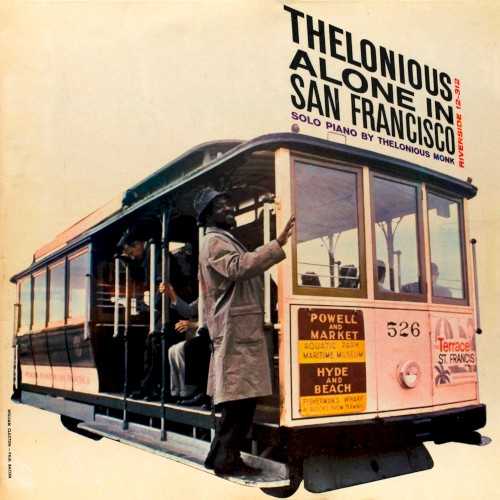 | Album: 14 of 39 Title: Thelonious Alone in San Francisco Released: 1959 Tracks: 10 Duration: 41:01 Scroll: Up Down Top Bottom 25% 50% 75% Spotify TrackSamples Allmusic Wikipedia AlbumCover | 1 Blue Monk (03:48) 2 Ruby, My Dear (04:00) 3 Round Lights (03:41) 4 Everything Happens to Me (05:40) 5 You Took the Words Right Out of My Heart (04:05) 6 Bluehawk (03:40) 7 Pannonica (03:54) 8 Remember (02:45) 9 Theres Danger in Your Eyes, Cherie (take 2) (04:22) 10 Reflections (05:06) |
| Thelonious Alone in San Francisco : Allmusic album Review : With the robust ambience of Fugazi Hall in San Francisco at his disposal, Thelonious Monk recorded ten unaccompanied tracks over two days to create a long-awaited sequel to his immensely endearing Thelonious Himself long-player. As had become somewhat customary for Monk, he brought with him a healthy sampling from his voluminous back catalog, cover tunes, as well as a few new compositions. What is most immediately striking about these recordings is the rich and accurate sound stage at Fugazi Hall. The overtones are rich and thoughtful in their ability to animate Monks recreations of some of his most endearing works, such as the pair that opens this set. "Blue Monk" still retains the proud stride and walking blues heritage of previous renderings. Adding a bit of off-tempo improvisation, Monk propels and emphasizes the rhythmic swing even harder. He is obviously also enjoying what he is hearing. The audible maturity guiding Monk through the familiar, albeit offbeat, chord progressions of "Ruby, My Dear" is striking. His nimble reflexes and split-second timing render this version superior. Again, the sound of the hall offers even more to enjoy from this performance. It is unfortunate that the playful solitude of "Round Lights" was never revisited. This freeform composition is framed within a blues structure, yet reveals all of the slightly askew freedom of a Monk original. The recreation of an old 1920s hit, "Theres Danger in Your Eyes, Cherie," is another of the highlights from Thelonious Alone in San Francisco that was never recorded again by Monk. The noir qualities are immeasurably enhanced by Monks oblique phrasings as well as the eerie resonance of the Fugazi. This is an absolute must-own recording -- Monk enthusiast or not. | ||
![Allmusic album Review : As the 50s drew to a close, so did Thelonious Monks illustrious tenure on Riverside Records. In fact, the three dates needed for this title would be his penultimate for the label. The concept of the album consists of five Monk originals performed in a quintet setting. Ironically, this was the first time that Monk had recorded with a lineup that so prominently featured the "standard" bop rhythm section incorporating both a trumpet (or, in this case, cornet) and sax player. The quintet featured on 5 by Monk by 5 includes Monk (piano), Thad Jones (cornet), Charlie Rouse (tenor sax), Sam Jones (bass), and Art Taylor (drums). Rouse would become Monks permanent tenor saxophonist for the majority of the 1960s. In what had become somewhat of a tradition, the discs program consists of several of Monks more established works as well as a few new compositions. One of the new works, "Jackie-ing" (incidentally, named after one of Monks nieces), leads off the disc. It exemplifies the loose, disjointed, and exceedingly difficult arrangements that would define Monk as a premier composer/arranger/bandleader. This is in contrast to Monk the keyboard player and band member, which he skilfully demonstrates throughout the track as well as the rest of the album. The songs opening jam features a tasty tug of war between Rouses animated lead and Monks interjections and piano antics. Jones cornet is incorporated tastefully throughout Monks tricky arrangements. The stark contrast in performance timbre between the comparatively subdued Rouse or Monk and the frenetic bleating of Jones is notably disconcerting. [Some reissues includes two alternate takes of "Played Twice," the other Monk composition to be debuted on 5 by Monk by 5.] 5_by_monk_by_5](../../images/thelonious_monk-5_by_monk_by_5.jpg) | Album: 15 of 39 Title: 5 by Monk by 5 Released: 1959 Tracks: 5 Duration: 43:38 Scroll: Up Down Top Bottom 25% 50% 75% Spotify Allmusic Wikipedia AlbumCover | 1 Jackie-ing (06:01) 2 Straight, No Chaser (09:16) 3 Played Twice (07:55) 4 I Mean You (09:43) 5 Ask Me Now (10:43) |
| 5 by Monk by 5 : Allmusic album Review : As the 50s drew to a close, so did Thelonious Monks illustrious tenure on Riverside Records. In fact, the three dates needed for this title would be his penultimate for the label. The concept of the album consists of five Monk originals performed in a quintet setting. Ironically, this was the first time that Monk had recorded with a lineup that so prominently featured the "standard" bop rhythm section incorporating both a trumpet (or, in this case, cornet) and sax player. The quintet featured on 5 by Monk by 5 includes Monk (piano), Thad Jones (cornet), Charlie Rouse (tenor sax), Sam Jones (bass), and Art Taylor (drums). Rouse would become Monks permanent tenor saxophonist for the majority of the 1960s. In what had become somewhat of a tradition, the discs program consists of several of Monks more established works as well as a few new compositions. One of the new works, "Jackie-ing" (incidentally, named after one of Monks nieces), leads off the disc. It exemplifies the loose, disjointed, and exceedingly difficult arrangements that would define Monk as a premier composer/arranger/bandleader. This is in contrast to Monk the keyboard player and band member, which he skilfully demonstrates throughout the track as well as the rest of the album. The songs opening jam features a tasty tug of war between Rouses animated lead and Monks interjections and piano antics. Jones cornet is incorporated tastefully throughout Monks tricky arrangements. The stark contrast in performance timbre between the comparatively subdued Rouse or Monk and the frenetic bleating of Jones is notably disconcerting. [Some reissues includes two alternate takes of "Played Twice," the other Monk composition to be debuted on 5 by Monk by 5.] | ||
 | Album: 16 of 39 Title: Thelonious Monk with John Coltrane Released: 1961 Tracks: 6 Duration: 37:47 Scroll: Up Down Top Bottom 25% 50% 75% Spotify Allmusic AlbumCover | 1 Ruby, My Dear (06:21) 2 Trinkle, Tinkle (06:40) 3 Off Minor (take 4) (05:15) 4 Nutty (06:38) 5 Epistrophy (alternate take) (03:09) 6 Functional (alternate take) (09:43) |
| Thelonious Monk with John Coltrane : Allmusic album Review : Universally regarded as one of the greatest collaborations between the two most influential musicians in modern jazz (Miles Davis notwithstanding), the Jazzland sessions from Thelonious Monk and John Coltrane should be recognized on other levels. While the mastery of the principals is beyond reproach, credit should also be given to peerless bassist Wilbur Ware, as mighty an anchor as anyone could want. These 1957 dates also sport a variety in drummerless trio, quartet, septet, or solo piano settings, all emphasizing the compelling and quirky compositions of Monk. A shouted-out, pronounced "Off Minor" and robust, three-minute "Epistrophy" with legendary saxophonists Coleman Hawkins, Gigi Gryce, and the brilliant, underappreciated trumpeter Ray Copeland are hallmark tracks that every jazz fan should revere. Of the four quartet sessions, the fleet "Trinkle Tinkle" tests Coltranes mettle, as hes perfectly matched alongside Monk, but conversely unforced during "Nutty" before taking off. Monks solo piano effort, "Functional," is flavored with blues, stride, and boogie-woogie, while a bonus track, "Monks Mood," has a Monk-Ware-Coltrane tandem (minus drummer Shadow Wilson) back for an eight-minute excursion primarily with Monk in a long intro, Trane in late, and Wares bass accents booming through the studio. This will always be an essential item standing proudly among unearthed live sessions from Monk and Coltrane, demarcating a pivotal point during the most significant year in all types of music, from a technical and creative standpoint, but especially the jazz of the immediate future. | ||
 | Album: 17 of 39 Title: Criss-Cross Released: 1963 Tracks: 12 Duration: 1:02:49 Scroll: Up Down Top Bottom 25% 50% 75% Spotify Allmusic AlbumCover | 1 Hackensack (04:14) 2 Tea for Two (03:48) 3 Criss-Cross (04:43) 4 Eronel (04:32) 5 Rhythm-A-Ning (03:54) 6 Dont Blame Me (remake take 1) (07:06) 7 Think of One (06:07) 8 Crepuscule With Nellie (02:46) 9 Pannonica (take 2) (06:47) 10 Coming on the Hudson (take 3) (07:32) 11 Tea for Two (take 9) (05:14) 12 Eronel (take 3) (05:59) |
| Criss-Cross : Allmusic album Review : Criss-Cross -- Thelonious Monks second album for Columbia Records -- features some of the finest work that Monk ever did in the studio with his 60s trio and quartet. Whether revisiting pop standards or reinventing Monks own classic compositions, Monk and Charlie Rouse (tenor sax), John Ore (bass), and Frankie Dunlop (drums) exchange powerful musical ideas, as well as provide potent solos throughout the disc. Fittingly, "Hackensack" -- a frenetic original composition -- opens the disc by demonstrating the bandleaders strength in a quartet environment. The solid rhythmic support of the trio unfetters Monk into unleashing endless cascades of percussive inflections and intoxicating chord progressions. The title cut also reflects the ability of the four musicians to maintain melodic intricacies that are at times so exigent it seems cruel that Monk would have expected a musician of any caliber to pull them off. "Tea for Two" showcases Monks appreciation for the great stride or "walking" piano style of James P. Johnson and Willie "The Lion" Smith. The arrangement here is lighter, and features a trio (minus Rouse) to accent rather than banter with Monks splashes of magnificence throughout. Likewise, Monks solo on "Dont Blame Me" is excellent. The extended runs up and down the keyboard cant help but reiterate the tremendous debt of gratitude owed to the original stride pianists of the early 20th century. The 1993 compact disc pressing of Criss-Cross sounds great and adds a version of "Pannonica" that was previously unissued at the time. Unfortunately, however, the liner notes originally used on the album jacket -- penned by "Pannonica"s namesake, Baroness Nica de Koenigswarter -- were replaced by those of a writer for Rolling Stone magazine. This is prime Monk for any degree of listener. | ||
![Allmusic album Review : Although often unrightfully maligned by self-proclaimed "purists," Thelonious Monk did some brilliant work during his early- to mid-60s stint for Columbia Records. Its Monks Time (1964) contains some of the best -- if not arguably the best -- studio sides that the pianist cut during his final years as a recording musician. The albums title turned out to be somewhat prophetic, as Time magazine featured Monk as the cover subject for its February 28, 1964, edition. Interestingly, he was to have been profiled by the periodical the previous November; however, the assassination of then-President John F. Kennedy took obvious precedence. It had been almost a full year since his previous studio release, Criss-Cross (1963), and there had been a significant alteration in the rhythm section, which now incorporated the respective talents of both Butch Warren (bass) and Ben Riley (drums) as well as longtime cohort Charlie Rouse (tenor sax). From four sessions in early 1964, Its Monks Time gathers four quartet and two solo sides, presenting the pinnacle of what these musicians offered stylistically as well as from the standpoint of presentation. There is sense of mischievous playfulness in Monks nimble keyboard work, especially notable on the beautifully off-kilter unaccompanied opening to "Lulus Back in Town," and the same practically impish quality also drives the solo performance on "Nice Work if You Can Get It." Both pop standards are prime examples of the bop pioneers inimitable approach to arranging, and also provide an uncanny insight to his influences. Immediately evident are the styles of stride legends from the well-known Willie "The Lion" Smith and James P. Johnson to the slightly more obscure and decidedly frenetic playing of Cliff Jackson, as well as the ragtime approach of Walter L. Rose. The results are bound together in Monks arithmetically advanced delivery and harmonic composition. The combo -- especially Rouse -- effectively supports and punctuates the tricky timing of "Stuffy Turkey" and the more aggressive bop of "Brakes Sake." The latter title also unleashes some tasty interaction between Monk and Rouse, sonically exemplifying their practically single-minded synergy. The concluding cut, "Shuffle Boil," is one of the lost gems of the artists later work. It sports an effortless swing over a sophisticated and challenging melodic structure. Bassist Warren steps up to the plate, providing a supple and pulsating bed for both Monk and Rouse as they trade solos. [In 2003, Legacy issued an expanded edition of Its Monks Time with a trio of bonus tracks, two of which were previously unavailable.] its_monks_time](../../images/thelonious_monk-its_monks_time.jpg) | Album: 18 of 39 Title: Its Monks Time Released: 1964 Tracks: 6 Duration: 48:12 Scroll: Up Down Top Bottom 25% 50% 75% Spotify Allmusic AlbumCover | 1 Lulus Back in Town (09:57) 2 Memories of You (06:07) 3 Stuff Turkey (08:12) 4 Brakes Sake (12:27) 5 Nice Work if You Can Get It (04:17) 6 Shuffle Boil (07:09) |
| It's Monk's Time : Allmusic album Review : Although often unrightfully maligned by self-proclaimed "purists," Thelonious Monk did some brilliant work during his early- to mid-60s stint for Columbia Records. Its Monks Time (1964) contains some of the best -- if not arguably the best -- studio sides that the pianist cut during his final years as a recording musician. The albums title turned out to be somewhat prophetic, as Time magazine featured Monk as the cover subject for its February 28, 1964, edition. Interestingly, he was to have been profiled by the periodical the previous November; however, the assassination of then-President John F. Kennedy took obvious precedence. It had been almost a full year since his previous studio release, Criss-Cross (1963), and there had been a significant alteration in the rhythm section, which now incorporated the respective talents of both Butch Warren (bass) and Ben Riley (drums) as well as longtime cohort Charlie Rouse (tenor sax). From four sessions in early 1964, Its Monks Time gathers four quartet and two solo sides, presenting the pinnacle of what these musicians offered stylistically as well as from the standpoint of presentation. There is sense of mischievous playfulness in Monks nimble keyboard work, especially notable on the beautifully off-kilter unaccompanied opening to "Lulus Back in Town," and the same practically impish quality also drives the solo performance on "Nice Work if You Can Get It." Both pop standards are prime examples of the bop pioneers inimitable approach to arranging, and also provide an uncanny insight to his influences. Immediately evident are the styles of stride legends from the well-known Willie "The Lion" Smith and James P. Johnson to the slightly more obscure and decidedly frenetic playing of Cliff Jackson, as well as the ragtime approach of Walter L. Rose. The results are bound together in Monks arithmetically advanced delivery and harmonic composition. The combo -- especially Rouse -- effectively supports and punctuates the tricky timing of "Stuffy Turkey" and the more aggressive bop of "Brakes Sake." The latter title also unleashes some tasty interaction between Monk and Rouse, sonically exemplifying their practically single-minded synergy. The concluding cut, "Shuffle Boil," is one of the lost gems of the artists later work. It sports an effortless swing over a sophisticated and challenging melodic structure. Bassist Warren steps up to the plate, providing a supple and pulsating bed for both Monk and Rouse as they trade solos. [In 2003, Legacy issued an expanded edition of Its Monks Time with a trio of bonus tracks, two of which were previously unavailable.] | ||
![Allmusic album Review : This is the sixth studio album cut by Thelonious Monk under the production/direction of Teo Macero for Columbia and as such should not be confused with the original motion picture soundtrack to the 1988 film of the same name. The band featured here includes: Monk (piano), Charlie Rouse (tenor sax), Ben Riley (drums), and Larry Gales (bass). This would be the final quartet Monk would assemble to record with in the studio. While far from being somber, this unit retained a mature flavor which would likewise place Monks solos in a completely new context. At times, this adaptation presents itself more subtly than others. For instance, Monks extended solo in "Locomotive" never reaches beyond itself due in part to the tempo-laden rhythm section. The contrast of styles, however, appreciates the caliber of this particular solo, including an obvious assertion by Monk which leads the band, albeit temporarily, into playing double-time. Other recommended quartet selections on this disc include a liberated version of the title track, which highlights some stellar interaction between Monk and Rouse. The same can be said for "We See," which features the hardest bop on the album. In addition to the quartet sides, Straight, No Chaser contains two unaccompanied piano solos: "Between the Devil and the Deep Blue Sea" and "This Is My Story, This Is My Song." [The original disc only included six performances, half of which were edited due to the stringent time constraints of vinyl; subsequent reissues not only restored all of the previously abridged performances, but also added a trio of sides, two of which ("I Didnt Know About You: Take 1" and "Green Chimneys") are issued here for the first time.] straight_no_chaser](../../images/thelonious_monk-straight_no_chaser.jpg) | Album: 19 of 39 Title: Straight, No Chaser Released: 1967 Tracks: 9 Duration: 1:16:05 Scroll: Up Down Top Bottom 25% 50% 75% Spotify Wikipedia Allmusic AlbumCover | 1 Locomotive (06:41) 2 I Didn’t Know About You (take 4) (06:52) 3 Straight, No Chaser (11:28) 4 Japanese Folk Song (Kojo no Tsuki) (16:42) 5 Between the Devil and the Deep Blue Sea (07:36) 6 We See (11:37) 7 This Is My Story, This Is My Song (01:42) 8 I Didn’t Know About You (take 1) (06:49) 9 Green Chimneys (06:34) |
| Straight, No Chaser : Allmusic album Review : This is the sixth studio album cut by Thelonious Monk under the production/direction of Teo Macero for Columbia and as such should not be confused with the original motion picture soundtrack to the 1988 film of the same name. The band featured here includes: Monk (piano), Charlie Rouse (tenor sax), Ben Riley (drums), and Larry Gales (bass). This would be the final quartet Monk would assemble to record with in the studio. While far from being somber, this unit retained a mature flavor which would likewise place Monks solos in a completely new context. At times, this adaptation presents itself more subtly than others. For instance, Monks extended solo in "Locomotive" never reaches beyond itself due in part to the tempo-laden rhythm section. The contrast of styles, however, appreciates the caliber of this particular solo, including an obvious assertion by Monk which leads the band, albeit temporarily, into playing double-time. Other recommended quartet selections on this disc include a liberated version of the title track, which highlights some stellar interaction between Monk and Rouse. The same can be said for "We See," which features the hardest bop on the album. In addition to the quartet sides, Straight, No Chaser contains two unaccompanied piano solos: "Between the Devil and the Deep Blue Sea" and "This Is My Story, This Is My Song." [The original disc only included six performances, half of which were edited due to the stringent time constraints of vinyl; subsequent reissues not only restored all of the previously abridged performances, but also added a trio of sides, two of which ("I Didnt Know About You: Take 1" and "Green Chimneys") are issued here for the first time.] | ||
 | Album: 20 of 39 Title: Underground Released: 1968 Tracks: 7 Duration: 41:40 Scroll: Up Down Top Bottom 25% 50% 75% Spotify TrackSamples Allmusic Wikipedia AlbumCover | 1 Thelonious (03:16) 2 Ugly Beauty (07:20) 3 Raise Four (05:50) 4 Boo Boos Birthday (05:55) 5 Easy Street (05:55) 6 Green Chimneys (09:03) 7 In Walked Bud (04:17) |
| Underground : Allmusic album Review : This release has long been considered Thelonious Monks acknowledgement to the flourishing youth-oriented subculture from whence the collection takes its name. Certainly the Grammy-winning cover art -- which depicts Monk as a World War II French revolutionary toting an automatic weapon -- gave the establishment more than the brilliant swinging sounds in the grooves to consider. Underground became Monks penultimate studio album, as well as the final release to feature the 60s quartet: Charlie Rouse (tenor sax), Ben Riley (drums), and Larry Gales (bass) behind Monk (piano). One of the motifs running throughout Monks recording career is the revisitation of titles from his voluminous back catalog. The tradition continues with the autobiographical leadoff track, "Thelonious." The instantly recognizable stride piano lines are delivered with the same urgency and precision that they possessed over two decades earlier when he first recorded the track for Blue Note. The presence of Charlie Rouse throughout the album is certainly worth noting. "Ugly Beauty" best captures the sacred space and musical rapport that he and Monk shared. Each musician functions as an extension of the other, creating solos that weave synchronically as if performed by the same pair of hands. Newer material, such as the playful "Green Chimneys" -- named after the school Monks daughter attended -- as well as the unbalanced hypnotism of "Raise Four," asserts the timelessness and relevance of Monks brand of bop. The disc ends as it begins with a new twist on an old favorite. Jon Hendricks -- who provides lyrics and vocals on "In Walked Bud" -- recalls the hustle and bustle of the real and spontaneous underground Harlem jam sessions of the late 40s. It is likewise an apt bookend to this chapter in the professional life of Thelonious Monk. | ||
 | Album: 21 of 39 Title: Monks Blues Released: 1969 Tracks: 11 Duration: 56:22 Scroll: Up Down Top Bottom 25% 50% 75% Spotify Allmusic Wikipedia AlbumCover | 1 Lets Cool One (03:47) 2 Reflections (04:38) 3 Rootie Tootie (07:34) 4 Just a Glance at Love (02:53) 5 Brilliant Corners (03:54) 6 Consecutive Seconds (02:43) 7 Monks Point (08:02) 8 Trinkle Tinkle (04:59) 9 Straight, No Chaser (07:19) 10 Blue Monk (06:16) 11 Round Midnight (04:13) |
| Monk's Blues : Allmusic album Review : Although nostalgia has allowed Monks Blues to age more gracefully than perhaps the recording deserves, it remains an unfortunate fact that Thelonious Sphere Monks final studio sessions were very poorly conceived. The idea of Monk performing with a big band was inspired nobly enough by the February 59 NYC Town Hall performance which was issued as Thelonious Monk Orchestra at Town Hall. These studio recordings fall far short of that classic live encounter. However there are a few brief moments of inspiration that are not overcome by random blasts from an over driven hollow sounding horn section. The challenge of arranging Monk for big band instrumentation fell upon Oliver Nelson, whose best remembered works include an array of television theme songs -- Ironside, Columbo and the Six Million Dollar Man among them. Many of the same techniques are likewise incorporated into the approach Nelson uses on Monk Blues. Perhaps it is cosmically fitting that the sessions were held at Columbia studios in tinsel town. There are a few write offs. "Rootie Tootie" is destroyed by an overwrought brass section which completely drowns Monk. "Consecutive Seconds" -- one of the two compositions penned by producer Teo Macero -- is simply abysmal. If this was an attempt to get Monk to play soul music it failed. It does succeed in sounding embarrassingly dated however. Thelonious genius shines through on some of the more sensible and sensitive arrangements such as "Reflections", "Monks Point" and the surprisingly tasteful "Brilliant Corners. The 1994 CD edition adds two performances not featured on the vinyl incarnation. "Blue Monk" features a stirring solo from Thelonious. "Round Midnight" is a previously unissued solo side cut at the Monks Blues sessions. The sheer brilliance in Monks emotive and seemingly frustrated intonations may well be an exorcism for the sins of the rest of the album. | ||
 | Album: 22 of 39 Title: Something in Blue Released: 1971 Tracks: 8 Duration: 39:38 Scroll: Up Down Top Bottom 25% 50% 75% Allmusic AlbumCover | 1 Blue Sphere (02:27) 2 Hackensack (07:55) 3 Nice Work If You Can Get It (05:14) 4 Criss Cross (03:44) 5 Something in Blue (06:41) 6 Evidence (05:26) 7 Jackie-Ing (03:30) 8 Nutty (04:41) |
 | Album: 23 of 39 Title: Monk/Trane Released: 1973 Tracks: 12 Duration: 1:20:33 Scroll: Up Down Top Bottom 25% 50% 75% AlbumCover | 1 Ruby My Dear (06:18) 2 Trinkle, Tinkle (06:38) 3 Nutty (06:36) 4 Well You Neednt (11:25) 5 Off Minor (alternate take 4) (05:12) 6 Off Minor (master take) (05:06) 7 Epistrophy (fragment) (01:45) 8 Epistrophy (10:45) 9 Crepuscule With Nellie (04:37) 10 Abide With Me (00:51) 11 Monks Mood (07:49) 12 Blues for Tomorrow (13:31) |
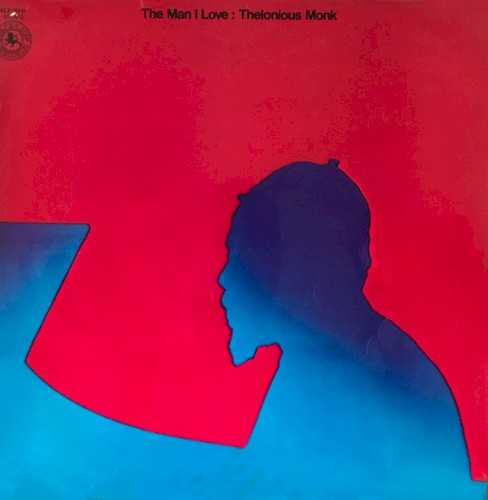 | Album: 24 of 39 Title: The Man I Love Released: 1973 Tracks: 7 Duration: 37:27 Scroll: Up Down Top Bottom 25% 50% 75% AlbumCover | 1 I Mean You (07:47) 2 The Man I Love (05:11) 3 Ruby My Dear (06:02) 4 Little Rootie Tootie (03:50) 5 Misterioso (06:23) 6 Trinkle Tinkle (05:53) 7 Crepescule With Nellie (02:20) |
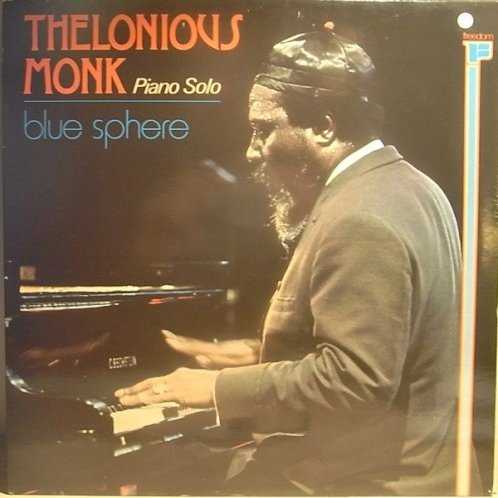 | Album: 25 of 39 Title: Blue Sphere Released: 1980 Tracks: 8 Duration: 35:22 Scroll: Up Down Top Bottom 25% 50% 75% AlbumCover | 1 Trinkle Tinkle (07:26) 2 Crepuscule With Nellie (02:20) 3 Darn That Dream (05:45) 4 Little Rootie Tootie (03:42) 5 Nice Work If You Can Get It (05:10) 6 My Melancholy Baby (05:12) 7 Jackieing (03:25) 8 Blue Sphere (02:22) |
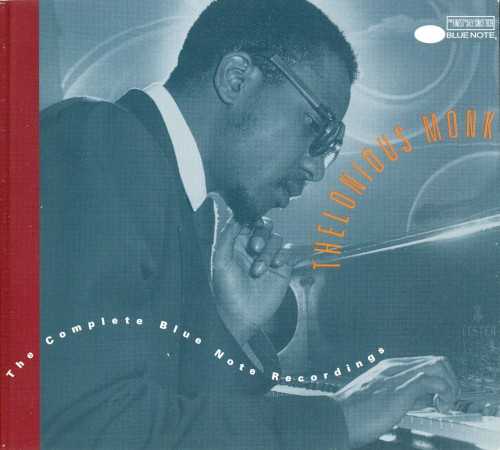 | Album: 26 of 39 Title: The Complete Blue Note Recordings of Thelonious Monk Released: 1983 Tracks: 49 Duration: 2:43:44 Scroll: Up Down Top Bottom 25% 50% 75% AlbumCover | 1 Humph (02:53) 2 Evonce (alternate take) (03:02) 3 Evonce (03:04) 4 Suburban Eyes (03:01) 5 Suburban Eyes (alternate take) (02:58) 6 Thelonious (03:01) 7 Nice Work If You Can Get It (alternate take) (03:03) 8 Nice Work If You Can Get It (03:03) 9 Ruby, My Dear (alternate take) (03:06) 10 Ruby My Dear (03:09) 11 Well, You Needn’t (02:59) 12 Well, You Needn’t (alternate take) (02:55) 13 April in Paris (alternate take) (02:42) 14 April in Paris (03:21) 1 Off Minor (03:01) 2 Introspection (03:12) 3 In Walked Bud (02:56) 4 Monk’s Mood (03:08) 5 Who Knows? (02:42) 6 ’Round Midnight (03:11) 7 Who Knows? (alternate take) (02:40) 8 All the Things You Are (02:59) 9 I Should Care (alternate take) (03:02) 10 I Should Care (03:01) 11 Evidence (02:34) 12 Misterioso (03:22) 13 Misterioso (alternate take) (02:45) 14 Epistrophy (03:08) 15 I Mean You (02:47) 1 Four in One (03:30) 2 Four in One (alternate take) (03:29) 3 Criss Cross (02:56) 4 Criss Cross (alternate take) (02:51) 5 Eronel (03:04) 6 Straight No Chaser (02:57) 7 Ask Me Now (alternate take) (04:28) 8 Ask Me Now (03:15) 9 Willow Weep for Me (03:00) 10 Skippy (03:01) 11 Skippy (alternate take) (03:10) 12 Hornin’ In (alternate take) (03:09) 1 Hornin’ In (03:14) 2 Sixteen (first take) (03:31) 3 Sixteen (second take) (03:40) 4 Carolina Moon (03:28) 5 Let’s Cool One (03:48) 6 I’ll Follow You (03:48) 7 Reflections (07:03) 8 Misterioso (09:22) |
 | Album: 27 of 39 Title: The Complete Black Lion and Vogue Recordings of Thelonious Monk Released: 1985 Tracks: 35 Duration: 2:46:30 Scroll: Up Down Top Bottom 25% 50% 75% Allmusic AlbumCover | 1 Well, You Neednt (03:24) 2 Smoke Gets in Your Eyes (03:21) 3 Off Minor (02:30) 4 Round Midnight (05:12) 5 Eronel (02:29) 6 Portrait of an Eremite (04:56) 7 Manganese (02:36) 8 Hackensack (02:59) 9 Evidence (03:03) 10 Chordially (09:50) 1 Trinkle Trinkle (take one) (05:46) 2 Trinkle Trinkle (take two) (05:51) 3 Trinkle Trinkle (take three) (07:19) 4 Lover Man (07:10) 5 Something in Blue (06:37) 6 My Melancholy Baby (05:06) 7 Little Rootie Tootie (04:03) 8 The Man I Love (05:11) 9 Jackie-ing (03:25) 10 Meet Me Tonight in Dreamland (03:10) 11 Darn That Dream (05:42) 12 Nice Work If You Can Get It (05:09) 13 Blue Sphere (02:21) 1 Evidence (05:20) 2 Misterioso (06:20) 3 Hackensack (take one) (09:03) 4 Hackensack (take two) (07:50) 5 Ruby My Dear (06:02) 6 Crepescule With Nellie (take two—solo) (02:14) 7 Crepescule With Nellie (take four) (02:18) 8 Nutty (04:40) 9 Criss Cross (03:40) 10 Introspection (take one—solo) (01:10) 11 Introspection (take two) (03:03) 12 I Mean You (07:40) |
| The Complete Black Lion and Vogue Recordings of Thelonious Monk : Allmusic album Review : The recordings gathered in this package have been issued in a multitude of ways and are available in a number of configurations. The audiophile jazz label Mosaic Records issued The Complete Vogue Recordings/The Black Lion Sessions on vinyl initially, later releasing the title as a slightly expanded three-CD package. Chronologically, the earlier of the two sets consists of the Vogue recordings from June 7, 1954. The Black Lion sides are divided between a second batch of solo works as well as a trio session -- featuring Al McKibbon (bass) and Art Blakey (drums) -- both of which were cut on November 11, 1971. The nine sides cut for the Parisian Vogue label are supposedly Monks very first solo studio recordings. Each of these pieces aptly capture the angular frolic that defines a Thelonious Monk performance. "Reflections" alternately bops with off-kilter rhythms and genuflects to Monks recurring fascination with the stride piano styling of James P. Johnson and Willie "The Lion" Smith. Of all the solo sides that Monk cut during the nearly 30 years he was actively recording, these stand among the zenith of his achievements. "Smoke Gets in Your Eyes" -- the one cover tune done at this session -- is likewise given a unique and exceedingly Monk reading. Although he would continue to make the occasional public appearance, the 1971 sets found here are Monks last known studio recordings. Both the solo and trio sides -- three volumes worth -- were cut during a mammoth session held the day after the final "Giants of Jazz" performance in London. This low-key affair truly highlights the brilliance of Monk within a group dynamic. "Criss Cross," "I Mean You," and two extended takes of "Hackensack" make this set required listening regardless of the historical implications. | ||
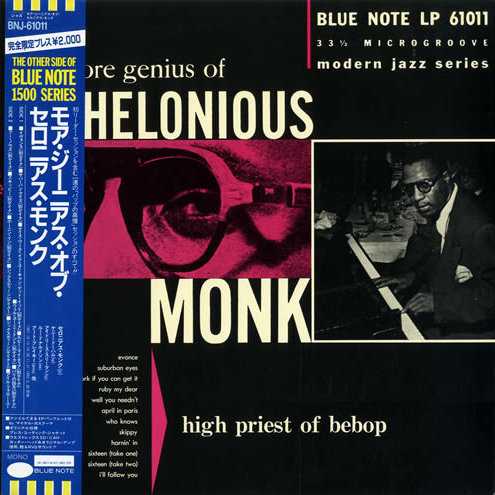 | Album: 28 of 39 Title: More Genius of Thelonious Monk Released: 1985 Tracks: 17 Duration: 54:16 Scroll: Up Down Top Bottom 25% 50% 75% AlbumCover | 1 Evonce (03:04) 2 Suburban Eyes (02:58) 3 Nice Work If You Can Get It (03:04) 4 Ruby My Dear (03:06) 5 Well You Neednt (02:56) 6 April in Paris (02:43) 7 Who Knows (02:43) 8 All the Things You Are (03:00) 9 I Should Care (alternate master) (03:03) 10 I Should Care (03:02) 11 Ask Me Now (04:28) 12 Criss Cross (02:51) 13 Skippy (03:10) 14 Horninin (03:10) 15 Sixteen (take 1) (03:31) 16 Sixteen (take 2) (03:40) 17 Ill Follow You (03:47) |
 | Album: 29 of 39 Title: The Complete Riverside Recordings Released: 1986 Tracks: 153 Duration: 16:14:58 Scroll: Up Down Top Bottom 25% 50% 75% Spotify Allmusic AlbumCover | 1 It Dont Mean a Thing (If It Aint Got That Swing) (04:40) 2 Sophisticated Lady (04:31) 3 I Got It Bad (and That Aint Good Enough) (05:55) 4 Black and Tan Fantasy (03:26) 5 Mood Indigo (03:14) 6 I Let a Song Go Out of My Heart (05:42) 7 Solitude (03:45) 8 Caravan (05:59) 9 Liza (All the Cloudsll Roll Away) (03:13) 10 Memories of You (04:17) 11 Honeysuckle Rose (05:34) 12 Darn That Dream (06:30) 13 Tea for Two (05:55) 1 You Are Too Beautiful (04:56) 2 Just You, Just Me (08:02) 3 Ba-lue Bolivar Ba-lues-are (13:27) 4 Pannonica (opening) (02:38) 5 Pannonica (08:54) 6 Brilliant Corners (07:51) 7 Bemsha Swing (07:55) 8 I Surrender, Dear (05:32) 1 I Dont Stand a Ghost of a Chance With You (take 5) (04:15) 2 I Dont Stand a Ghost of a Chance With You (take 7) (04:25) 3 I Should Care (take 1) (03:32) 4 I Should Care (take 2) (03:23) 5 I Should Care (take 3) (03:17) 6 Round Midnight (in progress) (21:59) 7 Round Midnight (take 7) (06:44) 8 April in Paris (03:55) 9 Im Getting Sentimental Over You (04:06) 10 Monks Mood (false start) (01:01) 11 Monks Mood (07:53) 1 Functional (alternate take 1) (09:44) 2 Functional (take 2) (09:20) 3 All Alone (04:53) 4 Crepuscule With Nellie (take 1) (04:34) 5 Crepuscule With Nellie (breakdown) (01:02) 6 Blues for Tomorrow (13:33) 7 Off Minor (alternate take 4) (05:15) 8 Off Minor (take 5) (05:10) 9 Abide With Me (00:55) 10 Crepuscule With Nellie (takes 4/5) (04:47) 11 Crepuscule With Nellie (take 6) (04:40) 1 Epistrophy (fragment) (01:48) 2 Epistrophy (10:47) 3 Well, You Neednt (opening) (01:26) 4 Well, You Neednt (11:26) 5 Ruby, My Dear (05:26) 6 Ruby, My Dear (06:20) 7 Nutty (06:41) 8 Trinkle, Tinkle (06:41) 9 Straight, No Chaser (alternate take 1) (05:31) 10 Straight, No Chaser (take 3) (07:01) 11 Rhythm-A-Ning (05:19) 1 I Mean You (alternate take 1) (06:24) 2 I Mean You (alternate take 2) (06:34) 3 I Mean You (take 4) (06:55) 4 Round Midnight (08:32) 5 Decidedly (stereo take 4) (05:56) 6 Decidedly (monaural take 5) (06:39) 7 Sweet and Lovely (07:18) 8 Coming on the Hudson (06:06) 9 In Orbit (04:44) 10 One Foot in the Gutter (07:21) 1 Trust in Me (04:34) 2 Lets Cool One (04:58) 3 Pea Eye (04:32) 4 Argentia (06:16) 5 Moonlight Fiesta (02:38) 6 Bucks Business (03:25) 7 Flugelin the Blues (07:04) 8 Very Near Blue (03:07) 9 Evidence (10:18) 10 Blues Five Spot (09:58) 11 In Walked Bud / Epistrophy (theme) (10:57) 1 [unidentified solo piano] (01:55) 2 Round Midnight (06:18) 3 Bye-Ya / Epistrophy (theme) (11:57) 4 Light Blue (05:15) 5 Coming on the Hudson (05:23) 6 Rhythm-A-Ning (09:28) 7 Just a Gigolo (02:09) 8 Blue Monk (08:29) 9 Evidence (08:45) 10 Epistrophy (theme) (01:07) 1 Nutty (05:23) 2 Blues Five Spot (08:12) 3 Lets Cool One (09:15) 4 In Walked Bud (11:20) 5 Misterioso (10:47) 6 Epistrophy (theme #2) (01:04) 7 In Walked Bud (07:08) 8 Blue Monk (08:20) 1 Rhythm-A-Ning (06:52) 2 Monks Mood (10:21) 3 Friday the 13th (09:30) 4 Little Rootie Tootie (08:52) 5 Off Minor (07:51) 6 Thelonious (03:04) 7 Crepuscule With Nellie (04:51) 8 Little Rootie Tooties (encore) (08:31) 1 Played Twice (take 1, 2nd alternate) (06:58) 2 Played Twice (alternate take 2) (07:55) 3 Played Twice (take 3) (08:02) 4 Straight, No Chaser (09:24) 5 Ask Me Now (10:47) 6 I Mean You (09:50) 7 Jackie-ing (06:10) 8 Round Lights (03:39) 9 Pannonica (03:55) 10 Blue Monk (03:44) 1 Ruby, My Dear (04:00) 2 Theres Danger in Your Eyes, Cherie (alternate take 1) (04:08) 3 Theres Danger in Your Eyes, Cherie (take 2) (04:22) 4 Everything Happens to Me (05:40) 5 Reflections (05:09) 6 Remember (02:47) 7 Bluehawk (03:40) 8 You Took the Words Right Out of My Heart (04:05) 9 San Francisco Holiday (08:54) 10 Just You, Just Me (07:12) 11 Round Midnight (07:58) 12 San Francisco Holiday (alternate take 2) (08:31) 1 Im Getting Sentimental Over You (06:14) 2 Evidence (07:10) 3 Epistrophy (theme) (01:04) 4 Epistrophy (06:42) 5 Four in One (take 1) (07:36) 6 Lets Call This (08:36) 7 Round Midnight (12:05) 8 San Francisco Holiday (Worry Later) (take 3) (09:11) 9 Four in One (take 2) (08:44) 10 Epistrophy (theme) (01:15) 1 Well, You Neednt (11:30) 2 Crepuscule With Nellie (02:39) 3 Jackie-Ing (10:12) 4 Body and Soul (02:47) 5 Off Minor (11:41) 6 April in Paris (01:18) 7 I Mean You (11:02) 8 Rhythm-A-Ning (10:37) 9 Just a Gigolo (01:45) 1 Hackensack (09:46) 2 Epistropy (06:12) 3 Im Getting Sentimental Over You (08:36) 4 Jackie-Ing (04:53) 5 Body and Soul (04:48) 6 Straight, No Chaser (09:03) 7 Crepuscule With Nellie (02:42) 8 Bemsha Swing (06:56) 9 San Francisco Holiday (05:57) 10 Rhythm-A-Ning (05:47) 11 Epistrophy (05:03) |
| The Complete Riverside Recordings : Allmusic album Review : The studio and live recording sessions that Thelonious Monk cut during his six-year stay at the Riverside label are compiled over the 15 discs in the Complete Riverside Recordings. This middle era -- between his early sides for Prestige and the final ones for Columbia -- is generally considered Monks most ingenious and creative period. The sessions are presented in chronological order, accurately charting the progression and diversions of one of the most genuinely enigmatic figures in popular music. The Complete Riverside Recordings explores Monks genius with a certain degree of real-time analysis that simply listening to each of the individual albums from this era lacks. This is due in part to the 14 additional performances exclusive to this collection. However, a more satisfying level of assessing Monks indelible marks of extemporaneous perfection can be heard within his prankster-like sense of timing or innate penchant for sophisticated arrangements. Among the sessions captured on this exhaustive set are the Duke Ellington sides and the Sonny Rollins era (which yielded the genre-defining Brilliant Corners), as well as meetings with Coleman Hawkins, John Coltrane, and Gerry Mulligan. Additionally, the entire Thelonious Monk Orchestra at Town Hall performance is presented just as it went down -- with solo and quartet sets intact. Accompanying the discs is a 28-page full-size (12"x12") booklet that is indispensable in dispelling myths and making sense of the convoluted and seemingly random order in which many of these recordings have been previously issued. It also contains a complete sessionography annotated by Monks producer during this era, Orrin Keepnews. This is a convenient, albeit pricey way to obtain all of this remarkable music. | ||
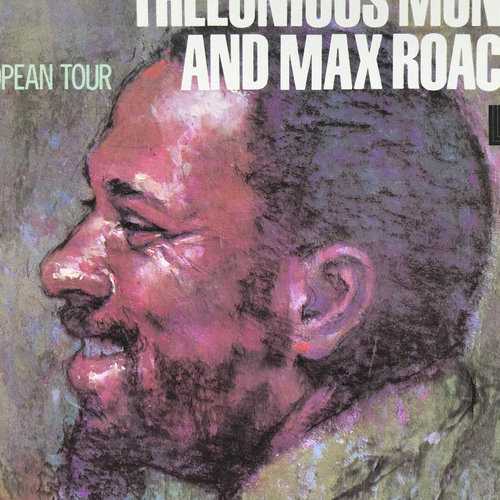 | Album: 30 of 39 Title: European Tour Released: 1989 Tracks: 5 Duration: 55:37 Scroll: Up Down Top Bottom 25% 50% 75% Allmusic AlbumCover | 1 Blue Monk (05:29) 2 Light Blue (11:10) 3 Evidence (11:48) 4 To Lady (12:41) 5 Stop Motion (14:29) |
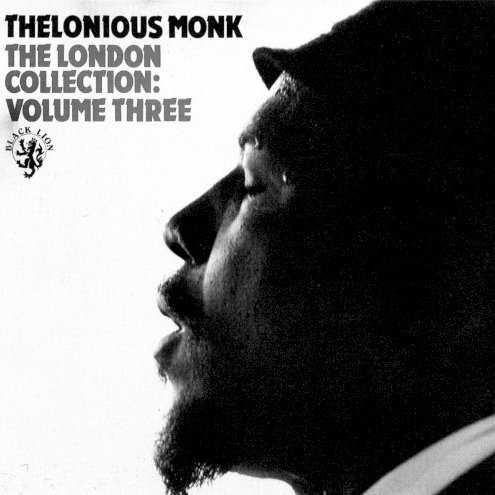 | Album: 31 of 39 Title: The London Collection Released: 1991 Tracks: 8 Duration: 44:19 Scroll: Up Down Top Bottom 25% 50% 75% AlbumCover | 1 Evidence (take 2) (05:21) 2 Misterioso (06:23) 3 Crepuscule With Nellie (take 4) (02:20) 4 I Mean You (07:47) 5 Criss Cross (03:39) 6 Ruby My Dear (06:09) 7 Nutty (04:45) 8 Hackensack (07:55) |
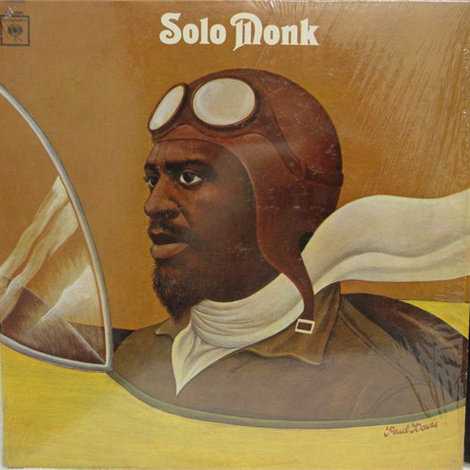 | Album: 32 of 39 Title: Solo Monk Released: 1992-04-21 Tracks: 13 Duration: 41:11 Scroll: Up Down Top Bottom 25% 50% 75% Spotify TrackSamples Allmusic AlbumCover | 1 Dinah (02:29) 2 I Surrender, Dear (03:44) 3 Sweet and Lovely (03:01) 4 North of the Sunset (01:53) 5 Ruby, My Dear (05:40) 6 Im Confessin (That I Love You) (02:39) 7 I Hadnt Anyone Till You (03:19) 8 Everything Happens to Me (03:30) 9 Monks Point (02:18) 10 I Should Care (01:59) 11 Ask Me Now (04:39) 12 These Foolish Things (Remind Me of You) (03:34) 13 Introspection (02:19) |
| Solo Monk : Allmusic album Review : The mystery and haunting angular beauty of Thelonious Monks unadorned keyboard sides are the focus of Solo Monk. As if holding the history of jazz in his hands, Monks solo recordings and performances from every phase of his career remain pure. The components of what made Monk such an uncompromising composer, arranger, and especially bandmember are evident in every note he plays. The disc includes both Monk originals as well as several covers of pop music standards. A majority of these sides were cut during a West Coast swing in late October and early November 1964. This highly productive jaunt would likewise yield two live releases: Live at the It Club and Live at the Jazz Workshop; both would feature Monks quartet. On an emotional level, however, these sides arguably surpass many of the band recordings. "Sweet and Lovely" contains several passages that are played with the command and intensity usually demanded of a classical work. The intense yet sophisticated chord progressions that punctuate "Ruby, My Dear" transform what once were simple pop melodies into unaccompanied rhapsodies. Monk transforms the solitude of "Everything Happens to Me" into a minor bop masterpiece replete with his signature disjointed phrasings and variable pacing. Parties interested in a more complete retrospective of Thelonious Monks 60s solo recordings should also check out Monk Alone: The Complete Columbia Solo Piano Recordings 1962-1968. | ||
 | Album: 33 of 39 Title: Blue Monk Released: 1999 Tracks: 6 Duration: 1:03:51 Scroll: Up Down Top Bottom 25% 50% 75% Spotify Allmusic AlbumCover | 1 Hackensack (11:07) 2 Light Blue (11:01) 3 Evidence (11:46) 4 Blue Monk (10:58) 5 Jackie-Ing (10:11) 6 Ruby, My Dear (08:45) |
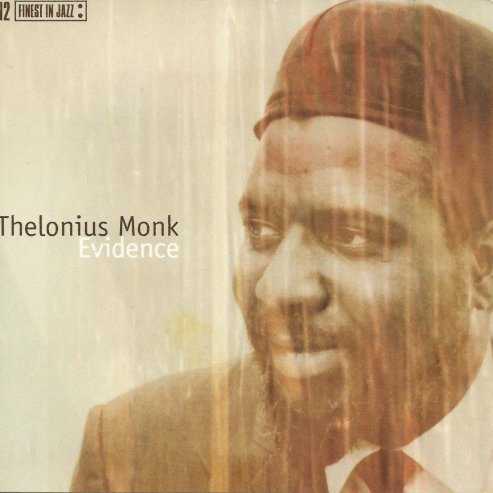 | Album: 34 of 39 Title: Evidence Released: 2000 Tracks: 5 Duration: 54:04 Scroll: Up Down Top Bottom 25% 50% 75% Allmusic AlbumCover | 1 Rhythm-A-Ning (09:12) 2 Off Minor (11:49) 3 Jackie-ing (10:11) 4 Evidence (11:44) 5 Hackensack (11:05) |
| Evidence : Allmusic album Review : This single LP complements the two-fer In Person by offering additional music from both of the sessions: the Town Hall concert of 1959 (all but a brief "Thelonious" were actually performances by his quartet) and a sextet gig from 1960 with trumpeter Joe Gordon and the tenors of Charlie Rouse and Harold Land. Although not essential (and this music has since been reissued on CD), these are excellent recordings by the unique pianist/composer. | ||
 | Album: 35 of 39 Title: After Hours at Mintons Released: 2001 Tracks: 12 Duration: 1:19:30 Scroll: Up Down Top Bottom 25% 50% 75% AlbumCover | 1 I Got Rhythm (09:17) 2 Nice Work If You Can Get It (04:02) 3 Down, Down, Down (03:39) 4 I Found a Million Dollar Baby (02:46) 5 Body and Soul (08:45) 6 Ive Found a New Baby (07:27) 7 My Melancholy Baby (08:29) 8 Sweet Lorraine (08:25) 9 Sweet Georgia Brown (05:20) 10 Youre a Lucky Guy (07:54) 11 Stompin at the Savoy (08:15) 12 Indiana (05:06) |
 | Album: 36 of 39 Title: We See Released: 2005 Tracks: 18 Duration: 1:14:47 Scroll: Up Down Top Bottom 25% 50% 75% Spotify AlbumCover | 1 We See (05:15) 2 Locomotive (06:21) 3 Smoke Get Out in Your Eyes (04:30) 4 Hackensack (05:09) 5 Blue Monk (07:37) 6 Just a Gigolo (02:59) 7 Little Rootie Tootie (03:04) 8 Reflections (04:59) 9 Bemsha Swing (03:08) 10 Sweet and Lovely (03:33) 11 These Foolish Things (02:46) 12 Bye-Ya (02:45) 13 Round Midnight (05:11) 14 Well You Neednt (03:23) 15 Monks Dream (03:05) 16 Nutty (05:16) 17 Evidence (03:04) 18 We See (02:35) |
 | Album: 37 of 39 Title: The Definitive Thelonious Monk on Prestige and Riverside Released: 2010 Tracks: 21 Duration: 2:25:20 Scroll: Up Down Top Bottom 25% 50% 75% Spotify Allmusic AlbumCover | 1 Bye‐Ya (02:47) 2 We See (05:16) 3 Blue Monk (07:38) 4 I want to be Happy (07:43) 5 Bemsha Swing (09:33) 6 Caravan (05:59) 7 Tea for Two (05:55) 8 Pannoncia (08:53) 9 Brilliant Corners (07:46) 10 Round Midnight (06:41) 1 Well You Neednt (11:25) 2 Off Minor (take 5) (05:10) 3 Epistrophy (03:10) 4 Trinkle, Tinkle (06:41) 5 Rhythm-A-Ning (05:19) 6 Evidence (08:50) 7 Nutty (05:23) 8 Little Rootie Tootie (08:56) 9 Straight, No Chaser (09:24) 10 Ruby My Dear (04:01) 11 Four in One (take 2) (08:44) |
| The Definitive Thelonious Monk on Prestige and Riverside : Allmusic album Review : The Definitive Thelonious Monk on Prestige and Riverside contains previously released tracks taken from the pianists and composers stint with the labels from 1952 to 1960. The 21 tracks, aimed at the casual listener, include the Monk penned classics " Round Midnight," "Straight, No Chaser," "Ruby, My Dear," "Bemsha Swing," and "Well, You Neednt." Appearing on these various dates are an extraordinary roster of musicians including Miles Davis, John Coltrane, Coleman Hawkins, Sonny Rollins and Charlie Rouse. Although its far from a perfect retrospective of his career, this set would make a fine companion to The Essential Thelonious Monk spotlighting the years 1947-1952 on Blue Note and The Essential Thelonious Monk on Columbia 1962-1968. Keep in mind that all the original albums remain in print as well. | ||
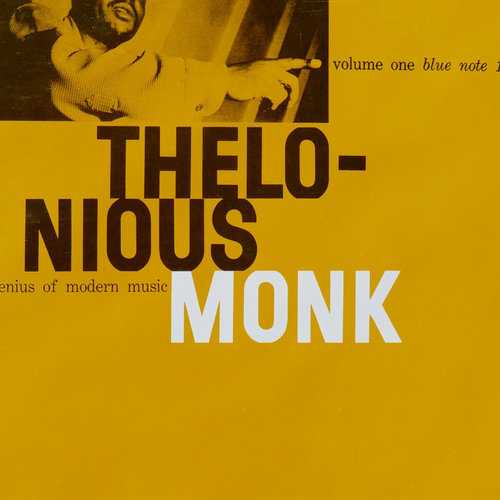 | Album: 38 of 39 Title: Genius of Modern Music Vol. Released: 2013-10-29 Tracks: 15 Duration: 45:56 Scroll: Up Down Top Bottom 25% 50% 75% Spotify AlbumCover | 1 Round Midnight (03:13) 2 Off Minor (03:02) 3 Ruby My Dear (03:09) 4 I Mean You (02:47) 5 April In Paris (03:23) 6 In Walked Bud (02:56) 7 Thelonious (03:01) 8 Epistrophy (03:08) 9 Misterioso (03:22) 10 Well You Neednt (02:59) 11 Introspection (03:13) 12 Humph (02:53) 13 Ruby My Dear (alternate take) (03:07) 14 April In Paris (alternate take) (02:43) 15 Well You Neednt (alternate take) (02:53) |
 | Album: 39 of 39 Title: Round Midnight Released: 2016-02 Tracks: 14 Duration: 55:39 Scroll: Up Down Top Bottom 25% 50% 75% AlbumCover | 1 The Fairy Queen: Overture (01:31) 2 The Satyr’s Dance (02:57) 3 Nachtmusik, op. 44: I. Nokturno (03:12) 4 Nachtmusik, op. 44: II. Barkorole (04:34) 5 Danse macabre, op 40 (07:05) 6 Brass Quintet: I. Little Requiem with Fanfares (10:29) 7 Brass Quintet: II. Barkarole (06:48) 8 Enchanted Forest Suite: I. Flight of the Unicorn (02:12) 9 Enchanted Forest Suite: II. Dance of the Gnomes and Faeries (03:11) 10 Enchanted Forest Suite: III. Song of the Water Nymphs (01:47) 11 Enchanted Forest Suite: IV. Daw of the Forest (02:16) 12 Round Midnight (03:44) 13 Old Devil Moon (02:50) 14 Requiem, op. 48: Pie Jesu (02:57) |